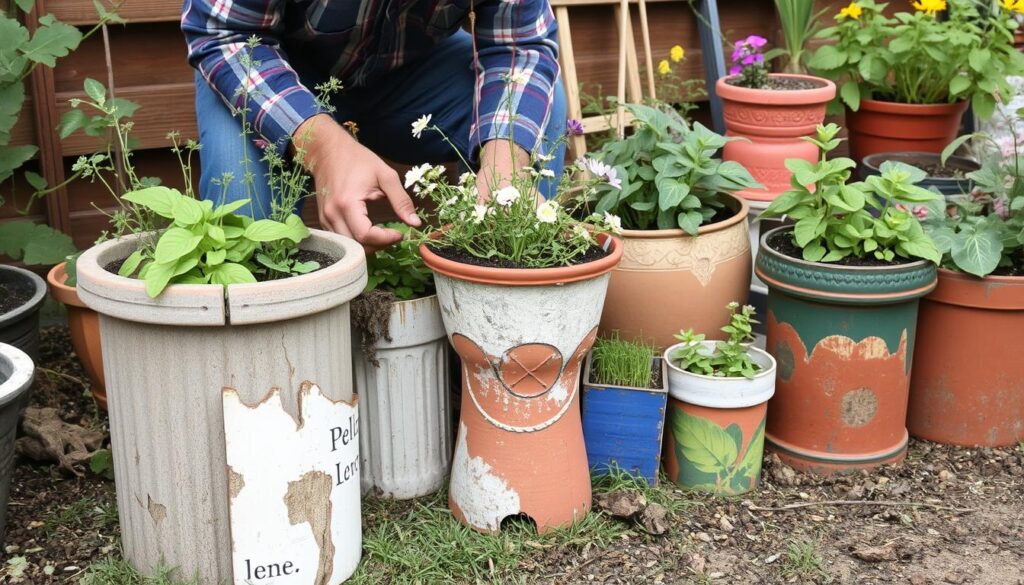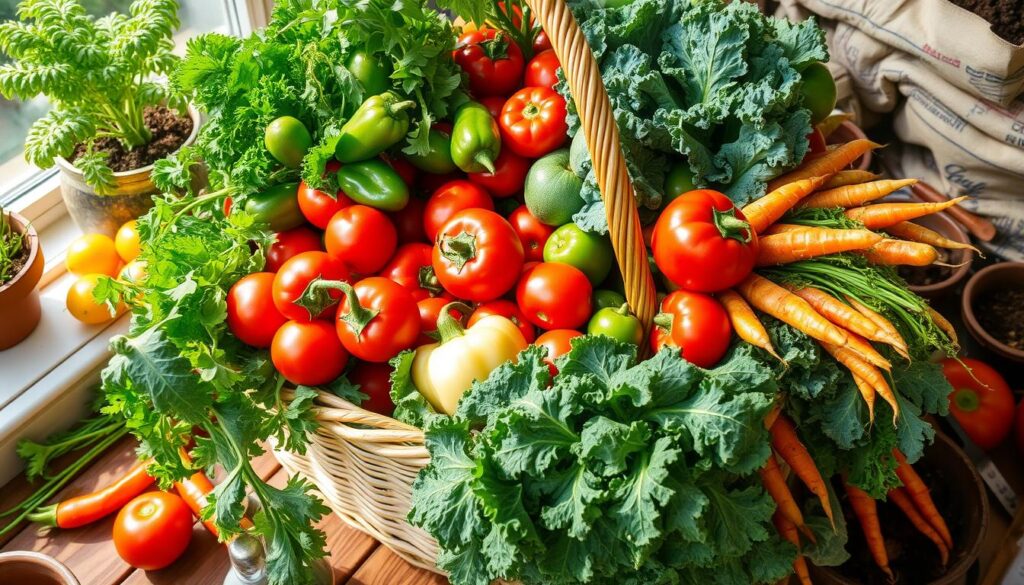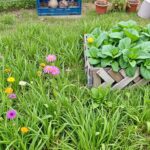Budget-Friendly Gardening: How to Create a Thriving Garden on a Tight Budget
Do you dream of a garden full of life but worry about the cost? You can make your outdoor space beautiful without spending a lot. But, how do you start when your budget is small?
Key Takeaways
- Use free resources like seed swaps and local garden centers for cheap plants and materials.
- Pick seeds and plants that are easy to grow and give lots of produce.
- Try saving money with composting, upcycling, and making things yourself.
- Look around your community for gardening groups, discounts, and ways to save.
- Grow plants that cost less but produce a lot to make your garden work harder for you.
Start with Free Resources
Starting a garden on a tight budget can be easier than you think. The sun’s light is free and vital for plants to grow well. You can also start your plants from seeds, which costs less than buying full plants.
Look around your community for free or cheap options. Local farms or community compost programs might give you free gardening resources like compost and manure. These are great budget-friendly gardening tips to make your soil rich. Using these free things, you can make a great garden on a tight budget without spending a lot.
- Utilize the sun’s natural light – a free and essential element for plant growth
- Start plants from seeds to save money compared to buying full-grown plants
- Seek out free or low-cost soil amendments like compost and aged manure from local sources
“Gardening is cheaper than therapy, and you get tomatoes.” – Unknown
By using these free resources, you can make a garden that’s both beautiful and productive without spending a lot. With a bit of creativity and resourcefulness, budget-friendly gardening is definitely possible.
Choose Low-Cost Seeds and Plants
Gardening can be rewarding without costing a lot. Saving money in your garden is easy by using low-cost seeds. Seeds are cheaper than buying plants or seedlings from a nursery. They are a great choice for budget-friendly plants.
Seed Saving
To save even more, try seed saving. Collect and store your own seeds to grow your favorite plants year after year. This way, you won’t need to buy new seeds every year. It’s a simple way to keep gardening costs low while growing from seed.
Many vegetables, herbs, and flowers can be grown from seed. Fast-growing crops like carrots, radishes, and lettuce are easy to start. With practice, you can master seed saving and have a low-cost garden every year.
“Seed saving is a game-changer for budget-conscious gardeners. It allows you to grow your favorite plants for free, year after year.”
Build Raised Beds on a Budget
Gardening fans often choose raised beds for a lush, productive garden. But, the cost can rise fast, especially with cedar or redwood lumber. Luckily, there are ways to make raised garden beds affordable.
Using cinder blocks or galvanized stock tanks is a smart choice for budget-friendly raised beds. These are cheap, strong, and simple to put together. Or, get creative with logs, pallets, or rocks for your DIY raised garden beds.
Another way to cut costs is making your own soil. Compost kitchen scraps and yard waste to create rich soil for your beds. This low-cost gardening solution boosts your plants and reduces waste.
Building raised beds on a budget takes time and effort. But, the benefits are huge. With creativity and hard work, you can have a great garden without spending a lot.
“Gardening is cheaper than therapy, and you get tomatoes.” – Unknown
Utilize Recycled and Upcycled Materials
Creating a garden on a budget means thinking creatively and using recycled materials. Instead of buying new tools and supplies, check out thrift stores, garage sales, or online for secondhand items. You can turn old pantyhose, kitchen tools, and other discarded items into unique garden decor and tools. This approach saves money and adds a special touch to your garden.
Creative Container Gardens
There are more ways to garden than just raised beds. Consider using buckets, barrels, or old sinks as containers. These upcycled gardening containers are budget-friendly and can make your garden stand out. They’re perfect for small spaces or patios, letting you create beautiful gardens without spending a lot.
“Gardening is the art that uses flowers and plants as paint, and the soil and sky as canvas.”
With creativity and a fresh perspective, you can turn your outdoor space into a lush, vibrant, and budget-friendly area. Using recycled materials for gardens and upcycled gardening methods saves money and adds a personal touch to your budget-friendly container gardens.
Budget-friendly gardening
Gardening on a tight budget is possible with creativity and resourcefulness. You can make a garden thrive without spending a lot. Focus on affordable gardening and cost-effective gardening to save money on gardening.
Begin by looking for free resources like seed libraries and online gardening groups. These can give you knowledge and plants at little or no cost. Choose cost-effective plants like seeds that you can save and replant.
Building raised beds is a budget-friendly idea. Use old pallets or repurposed wood to make them. This saves money and adds a personal touch to your garden.
- Explore free resources like seed libraries and plant swaps
- Choose affordable seeds and plants that can be saved and reused
- Construct raised beds using recycled or upcycled materials
- Embrace frugal gardening practices like composting and rainwater harvesting
- Create DIY garden tools and accessories from repurposed items
Using these budget-friendly gardening tips, you can have a great garden without spending a lot. With creativity and starting small, you can make a beautiful, cost-effective garden. It will feed your body and your wallet.
Embrace Frugal Gardening Practices
Creating a garden on a tight budget can be done with frugal gardening practices. Techniques like composting and companion planting help you save money. They also make your garden more productive.
One key to saving money is making your own compost. Use kitchen scraps and yard waste to create nutrient-rich soil. This way, you avoid expensive fertilizers and support healthy plants. Sustainable gardening means being smart with resources and reducing waste.
Another way to save is through companion planting. Choose plants that help each other out. For instance, marigolds can keep aphids away from your veggies. Frugal gardening tips like this make your garden both healthy and affordable.
Attracting helpful insects like bees and ladybugs can also save you money. These insects help control pests and keep your plants healthy. By using these methods, you can have a great garden without spending a lot.
“Gardening is an exercise in patience and optimism. No matter how bad the weather, how poor the soil, or how many bugs, a gardener always believes that next year will be better.” – Rosalie Muller Wright
Frugal gardening is about being clever, patient, and flexible. With these strategies, you can have a beautiful garden on a budget. And you’ll enjoy the rewards for many years.

| Frugal Gardening Practice | Benefits |
|---|---|
| Composting | Provides nutrient-rich soil, reduces waste |
| Companion Planting | Naturally deters pests, reduces need for pesticides |
| Attracting Beneficial Insects | Controls garden pests, promotes plant health |
DIY Garden Tools and Accessories
Gardening is a rewarding hobby, but it can get expensive. Luckily, you can make your own tools and accessories without spending a lot. Start by looking for secondhand tools at thrift stores, garage sales, or online. Over time, you can buy better tools that last longer. But starting with cheaper options helps you see which tools you really need for your DIY garden tools.
Upcycled Garden Decor
Make your outdoor space special with upcycled garden decor. Be creative and turn household items into garden decorations. You can use old tin cans as planters or turn windows into garden frames. Upcycling saves money and adds a unique touch to your budget-friendly gardening tools.
- Repurpose glass jars or bottles as unique planters
- Turn old pallets into raised garden beds or vertical plant stands
- Upcycle old tires into vibrant flower planters
- Use reclaimed wood to create custom garden signs or trellises
By making your own tools and decorations, you can garden without spending a lot. Embrace the DIY spirit and show off your creativity with upcycled garden decor that’s all your own.
Swap and Share with Community
Connecting with your local gardening community can be a great way to get plants, seeds, and resources for little to no cost. Look for plant swaps, seed exchanges, or neighborhood plant sales. Here, you can trade your extra seedlings or divisions for new plants. You might also meet gardeners ready to share cuttings, seeds, or advice.
Sharing and exchanging can greatly help in making your garden thrive on a budget. Fostering relationships within your local gardening community lets you get plants, materials, and knowledge without buying everything new.
| Benefit | Description |
|---|---|
| Access to Free or Low-Cost Resources | Join plant swaps, seed exchanges, and community plant sales to get new plants and materials without spending a lot. |
| Knowledge Sharing | Meet experienced gardeners in your area who can give valuable advice and insights to help your garden grow. |
| Fostering Community | Building relationships with other gardeners in your area creates a sense of community and can lead to lasting connections and support. |
By tapping into your local gardening community, you can access a lot of shared gardening resources and expertise. This can help revitalize your garden on a tight budget.
Grow Low-Cost, High-Yield Crops
When you’re on a tight budget, focus on growing crops that give you the most value. Look for high-yielding vegetables, cost-effective crops, and budget-friendly gardening options. These are easy to grow and produce a lot of food.
Some of the most productive and cost-effective crops to consider include:
- Tomatoes: A single tomato plant can yield several pounds of juicy, flavorful fruit.
- Zucchini: This prolific vegetable can provide an impressive number of squash per plant.
- Beans: Both bush and pole beans are simple to grow and can deliver a bountiful harvest.
- Leafy greens: Lettuce, kale, and spinach grow quickly and can be harvested repeatedly.
- Herbs: Fresh herbs like basil, parsley, and thyme add flavor to your meals and are easy to cultivate.
By choosing high-yielding vegetables and cost-effective crops, you can make the most of your gardening efforts. This way, you create a productive, budget-friendly gardening space.
“The key to a successful, budget-friendly garden is to focus on plants that give you the most bang for your buck.”

The goal is to grow as much food as possible with minimal investment. With a little planning and the right crop choices, you can enjoy a thriving garden. This garden will nourish your family and help your wallet too.
Preserve and Store Your Harvest
After enjoying your budget-friendly garden, it’s key to keep your harvest safe. Learn how to canning and freezing to enjoy your garden’s preserving garden harvest even when it’s not in season.
Canning and Freezing Techniques
Canning lets you keep fruits, veggies, and herbs in jars, making them last for months. It’s a great way to extend garden bounty and reduce waste. Or, freezing is fast and easy, keeping your garden’s best flavors and nutrients for later.
- Learn water bath canning for things like tomatoes, berries, and pickles.
- Try pressure canning for veggies that aren’t acidic, for safety and long storage.
- Freeze fruits and veggies when they’re ripe for eating all year.
- Check out dehydrating for tasty dried herbs, fruits, and veggies.
| Preservation Method | Pros | Cons |
|---|---|---|
| Canning | – Keeps food safe for a long time – Keeps nutrients and taste – Saves money |
– Needs special tools – Takes a lot of time |
| Freezing | – Keeps food fresh and full of nutrients – Quick to use – Fits easily into recipes |
– Needs freezer space – Can cause freezer burn |
| Dehydrating | – Makes food last longer – Makes flavors stronger – Takes up less space and is easy to store |
– Needs special tools – Can take a lot of time |
Learning these preserving garden harvest methods lets you enjoy your garden’s taste all year. It’s a great way to use your gardening skills wisely.
Seek Out Local Resources and Discounts
Being a budget-conscious gardener can really pay off. Look beyond big-box stores for community gems that save you money. These spots can help you cut down on gardening costs.
Begin by finding plant sales, seed swaps, or gardening classes in your area. Local groups, nonprofits, and extension services often host these events. They offer plants, seeds, and advice at low prices. This makes them perfect for smart gardeners. By using local gardening resources, you can grow a beautiful garden without spending a lot.
Also, talk to local nurseries, home improvement stores, or landscape suppliers. They might give discounts for gardeners who buy in bulk or during special sales. Discounts on soil, mulch, or other budget-friendly gardening supplies can really help you save.
| Local Resource | Potential Savings |
|---|---|
| Plant sales | 50-80% off retail prices |
| Seed swaps | Free or low-cost seeds |
| Gardening classes | Discounted or free admission |
| Bulk purchasing | 10-20% off regular prices |
Using these local resources and discounts can help you have a great garden on a budget. Embrace the community spirit and enjoy your garden without overspending.
Conclusion
Gardening on a tight budget is totally doable with creativity and smart choices. You can use free resources, pick low-cost seeds and plants, and make your own raised beds. This way, you can have a great garden without spending a lot of money. Use budget gardening, cost-effective gardening, and frugal gardening tips to make your outdoor area a lush paradise.
Using recycled materials and community resources can also help save money. By composting, planting together with other plants, and keeping your harvest, you can get more from your garden. Join your local gardening group to find deals and share tips, making your budget gardening even better.
With patience and creative thinking, your cost-effective gardening can grow into a beautiful, self-supporting garden. Follow the frugal gardening tips in this article and start a gardening journey that’s good for your wallet and your spirit.
FAQ
How can I start a garden on a tight budget?
What are some budget-friendly options for raised garden beds?
How can I incorporate recycled and upcycled materials into my garden?
What are some frugal gardening practices I can adopt?
How can I connect with my local gardening community to save money?
What are some low-cost, high-yielding crops I should focus on growing?
How can I preserve and store my garden’s bounty to extend its benefits?
Where can I find local resources and discounts to save money on gardening supplies?
Source Links
- How to Start a Garden on a Budget – https://www.tenthacrefarm.com/how-to-start-a-garden-on-a-budget/
- Simple Gardening on a Tight Budget – https://thehumbledhomemaker.com/simple-gardening-tight-budget/
- Dirt Cheap: 12 Easy Ways to Garden on a Budget – https://zerowastehomestead.com/dirt-cheap-12-easy-ways-to-garden-on-a-budget/
- 10 Must-Have Blooms for Your 2025 Garden
- The Health Advantages of Gardening You Need to Know
- How to Create a Small Vegetable Garden Layout Plan: A Beginner’s Guide
- DIY Garden Projects for Small Spaces: Upcycling Ideas to Maximize Your Garden
- Watering Techniques for Small Gardens: Ensuring Your Plants Thrive
- Small Border Plants for Landscaping: Adding Beauty and Functionality to Your Garden
- Year-Round Small Space Gardening: Seasonal Planting Tips for Maximum Harvest
- Essential Tools for Small-Space Gardening: What You Really Need
- The Ultimate Guide to Container Vegetables: What to Grow in Small Spaces
- Budget-Friendly Gardening: How to Create a Thriving Garden on a Tight Budget
- How to Optimize Sunlight in Small Gardens: Tips for Better Plant Growth
- DIY Vertical Planters: Creative Ideas for Small Space Gardening
- Companion Planting for Small Vegetable Gardens: Boost Growth and Deter Pests
- Container Gardening Essentials: Choosing the Right Pots, Soil, and Plants
- Vertical Gardening Techniques: Maximizing Your Small Space with Climbers and Vines
- How to Build a Raised Bed Garden in a Small Backyard: Step-by-Step Guide
- The Best Vegetables for Small-Space Gardens: High-Yield Varieties You Need to Grow
- Smart Vegetable Garden Layouts for Small Spaces: Maximizing Your Green Thumb in Compact Areas
- 40. Best Practices for Managing a Sustainable Garden Year-Round
- Building a Wildlife Pond for Biodiversity
- Advanced Techniques in Sustainable Gardening
- How to Create a No-Till Garden
- The Mental Health Benefits of Gardening
- Using Technology to Enhance Sustainable Gardening
- Getting Certified Organic: Steps and Benefits

Leave a Reply